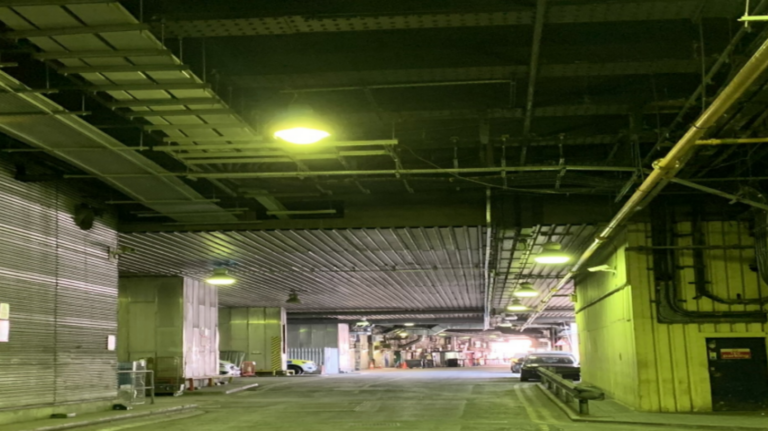A six-month trial beneath London’s Waterloo Station is testing how disused rail infrastructure can power zero-emission, multimodal freight, offering a scalable blueprint for sustainable last-mile deliveries across the UK capital.
In 1994, as the cultural phenomenon of ‘Cool Britannia’ took hold, the UK was busy constructing
a literal connection beneath the waves. That May, the inaugural journey of Eurostar’s international high-speed rail service departed from Waterloo Station, with five new platforms built to accommodate the service. By 2007, Eurostar’s Waterloo terminal was handling over eight million passengers annually. However, the move to St Pancras International in late 2007 left a void – both above and below ground.
While the platforms were swiftly reincorporated into South Western Railway’s domestic services, the undercrofts – structural chambers first created during the Victorian railway boom – remained largely unused. Initially designed for non-passenger operations such as customs, baggage and crew facilities, these spaces were heavily modified for Eurostar’s needs. By 2018, the platforms were fully refurbished, but the undercrofts, out of sight, sat idle.
FAST FACT: Freight vehicles account for 15% of London’s total vehicle miles yet contribute to 25% of the capital’s transport carbon emissions. Source: Cross River Partnership
Cross River Partnership (CRP), a public-private collaboration focused on sustainable urban development, saw untapped potential in this subterranean space. In early 2025, CRP launched a six-month trial to test the viability of converting 1,800ft² of the undercroft into a zero-emission freight hub, with the aim of integrating rail, e-cargo bikes and, eventually, river transport. The initiative supports CRP’s broader Smarter Greener Logistics programme, funded by the UK Department for Environment, Food and Rural Affairs, which seeks to reduce freight’s impact on London’s noise levels, air quality and congestion.
According to Transport for London, freight currently contributes to 25% of London’s road transport emissions – a figure set to rise as e-commerce drives parcel deliveries toward a projected one billion annually by 2030. CRP’s trial aims to demonstrate that existing urban infrastructure can be creatively repurposed to counter these trends, offering a scalable, sustainable model for last-mile logistics.
Dan Fredriksson, freight development manager at Network Rail – the site’s proprietor – explains: “Waterloo Station offers a unique opportunity to embed freight into the urban fabric. Our partnership with CRP explores how underused station infrastructure can support zero-tailpipe emission logistics.”
Operating with just 10 e-cargo bikes, logistics partner Delivery Mates receives inbound parcels by van, sorts them at the hub, and delivers across London. Kevin Savage, chief executive officer at Delivery Mates, emphasises the design’s efficiency: “Each cargo bike displaces a van, reducing emissions and congestion. We forecast cutting van mileage by around 276 miles each day.”

According to CRP, similar models trialled across London have demonstrated an 81% reduction in vehicle mileage, 88% drop in fuel usage, and a 55% cut in CO₂ emissions per parcel when compared to traditional last-mile van delivery models. These figures provide a compelling rationale for wider adoption.
But the ambitions extend far beyond the current scope. If successful, CRP envisions scaling operations across 100,000-200,000ft² of undercroft space, serving up to 3.5 million people and 200,000 businesses within a 5km radius. This would not only bolster London’s freight capacity but also foster an estimated 165 green jobs.
Ross Phillips, sustainable transport project manager at CRP, elaborates: “This trial provides tangible data on how multimodal logistics can function in an urban environment. By proving efficiency on a small scale, we pave the way for wider rail freight integration, improving air quality and economic resilience.”
This initiative also reconnects with London’s historical reliance on rail and river freight – modes that once formed the backbone of urban goods movement before road haulage became dominant. In many ways, Waterloo represents a return to – and reimagining of – a more sustainable logistics past.
Deep impact
The Waterloo Freight Hub trial builds on findings from CRP’s ‘On Track for Sustainable Logistics’ series, which champions rail freight’s role in decarbonising London’s supply chains. The reports highlight the benefits of replacing heavy goods vehicle (HGV) journeys with rail and micromobility solutions. One study estimates that incorporating rail freight could reduce London’s CO₂ emissions by up to 4,000 tonnes annually if scaled citywide.
Fredriksson adds: “Network Rail’s target is to grow rail freight by 75% by 2050. Initiatives like this are crucial in attracting new markets to rail. With the Waterloo trial, we’re demonstrating practical ways station infrastructure can support courier, express, and parcel logistics.”
The modal shift from HGVs to rail and e-cargo bikes addresses multiple challenges. Urban hubs typically face constraints such as high land values, limited space, and stringent environmental regulations. By repurposing existing infrastructure, the Waterloo hub sidesteps these issues while aligning with Lambeth Council’s Climate Action Plan and Net Zero 2030 targets.
Trial metrics at a glance
Duration: March-August 2025
Operator: Delivery Mates
Inbound method: Vans (future rail/river integration planned)
Outbound method: 10 e-cargo bikes
Hub size: 1,800ft²
Rezina Chowdhury, Lambeth Council’s deputy leader and cabinet member for sustainable Lambeth and clean air, notes: “This project is a huge stride in our journey toward net zero. It supports clean economic growth, creates new jobs, and improves air quality.”
The trial also reflects broader market shifts. The UK’s courier, express, and parcel (CEP) sector was valued at approximately £16.8bn in 2024, with projections indicating a compound annual growth rate of 7% through 2034, according to Expert Market Research. Despite this robust growth, rail freight currently serves only a small fraction of the CEP market.
Data from the Office of Rail and Road indicates that rail accounts for 4% of freight lifted and 7% of freight moved across all sectors, with the CEP segment representing an even smaller share. This underlines the significant potential for rail to play a larger role in the CEP sector, particularly through initiatives like the Waterloo Station freight hub trial, which aims to integrate rail into urban logistics and reduce emissions.

“Waterloo Station offers a unique opportunity to embed freight into the urban fabric. Our partnership with CRP explores how underused station infrastructure can support zero-tailpipe emission logistics” – Dan Fredriksson, freight development manager, Network Rail
In addition to its environmental and economic goals, the trial explores potential for future middle-mile operations via dedicated rail freight services. A longer-term vision includes direct rail links from UK distribution centres and ports to Waterloo, complementing the current road-fed model. CRP’s research suggests that a dedicated freight train serving Waterloo could remove the equivalent of 99 HGVs per annum, cutting CO₂ emissions by 4,000 tonnes.
Delivery Mates’ Savage sees vast potential: “Integrating rail with last-mile delivery creates a powerful model for sustainable logistics. The Waterloo trial shows how we can synchronise these modes to deliver at scale, cutting emissions and congestion.”
Further research by CRP and Steer highlights how the so-called ‘parcels as passengers’ model – using surplus space on existing passenger trains for small consignments – could complement dedicated freight services. This approach capitalises on underused rail capacity while avoiding the need for significant infrastructure investment. If adopted alongside dedicated freight multiple units, the result could be a resilient multimodal network capable of absorbing London’s projected delivery demands.
Removing roadblocks
However, these concepts face hurdles. Stakeholder engagement indicates that double-handling costs, station capacity constraints, and the absence of commercial incentives for passenger train operators are barriers to scale. CRP has thus proposed the creation of a dedicated working group to unite stakeholders across logistics, rail, infrastructure, and policymaking, ensuring coordination and removing roadblocks to national scale-up.
Looking forward, scalability will also hinge on replicability across other urban rail stations. CRP’s strategy briefing outlines Waterloo as a pilot that could inform similar deployments in stations such as Liverpool Street, Victoria, and London Bridge – each with their own spatial dynamics and freight potential. These locations offer varying proximity to key commercial districts and waterways, enabling nuanced multimodal combinations. For instance, Waterloo’s closeness to the Thames makes river freight integration a realistic enhancement. Trials in these stations could help identify best practices in adapting infrastructure, engaging stakeholders, and securing funding.
FAST FACT: Up to 91% CO2 reduction could be achieved by shifting parcels into London via rail with last-mile zero-emission vehicles. Source: Cross River Partnership
Funding models are a recurring concern. CRP’s research suggests mixed public-private investment, supported by national decarbonisation policies, could offer the financial structure needed to scale these hubs. There are also calls for the UK Department for Transport to establish a dedicated urban freight innovation fund to bridge early-stage operational risk. Without long-term financial commitment, even the most promising hubs risk under-delivery.
Still, the Waterloo hub exemplifies the growing clamour for integrating rail freight into urban logistics. As Network Rail’s Fredriksson concludes: “By creatively repurposing space and fostering modal shifts, we can deliver environmental benefits that align with central government decarbonisation plans.”
Projected benefits
Environmental impact projections:
- CO2 savings: 2,500 tonnes/year (if scaled)
- Congestion reduction: equivalent to removing 165 vans from the road daily
Economic benefits:
- £44m turnover for local businesses per annum (if scaled)
- £1.4m annual environmental, social and economic benefits from rail freight
With the trial results due later this year, CRP and its partners are keen, to analyse key performance indicators, including emissions reductions, route optimisation, delivery speed, cost savings, and stakeholder satisfaction. This data will be vital in influencing local and national policy, demonstrating that sustainable freight can be both commercially viable and environmentally beneficial.
A successful outcome could position Waterloo Station as the blueprint for the UK’s future urban logistics model, supporting national decarbonisation targets and fostering innovation across the urban logistics sector. Stakeholders across London’s freight ecosystem are watching closely, hopeful that Waterloo’s transformation will inspire the other logistics hubs development across the UK capital and beyond.
This article was originally published in the May 2025 issue of CiTTi Magazine.
Achievements and innovations in urban logistics will be recognised and celebrated at the fourth annual CiTTi Awards on 25 November 2025 at De Vere Grand Connaught Rooms in London. Visit www.cittiawards.co.uk to learn more about this unmissable event for the UK’s transportation sector!





